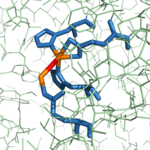Carboxypeptidase A
From Proteopedia
(Difference between revisions)
| Line 8: | Line 8: | ||
==Structure== | ==Structure== | ||
| - | Bovine CPA exists as a single unit with [http://en.wikipedia.org/wiki/Molecular_symmetry C1 symmetry] in the pancreatic physiological environment. According to [http://www.rcsb.org/pdb/explore/remediatedSequence.do?structureId=3CPA structural information] deposited in the PDB database, the single polypeptide chain of CPA contains a mixture of <scene name='69/694222/3cpasecondarystructure/1'>α-helices and β-sheets</scene>, of which there are a total of 11 helices (one [http://en.wikipedia.org/wiki/310_helix 3<sub>10</sub>], eight [http://en.wikipedia.org/wiki/Alpha_helix 3.6<sub>13</sub>]) and ten [http://en.wikipedia.org/wiki/Beta_sheet β-strands]. The helices are shown in magenta, and the β-strands are displayed in yellow. | + | Bovine CPA exists as a single unit with [http://en.wikipedia.org/wiki/Molecular_symmetry C1 symmetry] in the pancreatic physiological environment. According to [http://www.rcsb.org/pdb/explore/remediatedSequence.do?structureId=3CPA structural information] deposited in the PDB database, the single polypeptide chain of CPA contains a mixture of <scene name='69/694222/3cpasecondarystructure/1'>α-helices and β-sheets</scene>, of which there are a total of 11 helices (one [http://en.wikipedia.org/wiki/310_helix 3<sub>10</sub>], eight [http://en.wikipedia.org/wiki/Alpha_helix 3.6<sub>13</sub>]) and ten [http://en.wikipedia.org/wiki/Beta_sheet β-strands]. The helices are shown in magenta, and the β-strands are displayed in yellow. A [http://en.wikibooks.org/wiki/Structural_Biochemistry/Chemical_Bonding/_Disulfide_bonds disulfide bond] connects the residues Cys138 and Cys161. The disulfide bond can be seen in yellow in the <scene name='69/694222/3cpaoverview/1'>original rotating figure</scene>. |
Six different biologically active forms of the CPA monomeric unit exist. <scene name='69/694222/3cpacleavageforms/1'>Three of these active forms</scene> are produced following the cleavage of amino acid residue segments from the initial [http://en.wikipedia.org/wiki/Zymogen zymogen], or proenzyme, by trypsin and chymotrypsin, which are also found in the pancreas. Cleavage by trypsin generates either the '''α-form''' (residues Ala1-Asn307) or the '''β-form''' (residues Ser3-Asn307). Chymotrypsin cleavage generates the '''γ-form''' (residues Asn8-Asn307). The α-form essentially is the protein without any additional residue cleavages. The Ala and Arg residues, shown in red and white respectively, are cleaved in the β-form. In addition to the red and white residues, the residues displayed in yellow are cleaved to give the γ-form. The <scene name='69/694222/3cpageneticforms/1'>other three active forms</scene> of CPA arise from [http://en.wikipedia.org/wiki/Genetic_variation genetic variation] in residues located at three separate positions of the polypeptide chain. The differences include the following: Ile/Val179, Ala/Glu228, and Val/Leu305.<ref name="CPA1" /> Each of the six biologically active monomeric units carry out the same function of hydrolyzing the C-terminal [http://en.wikipedia.org/wiki/Peptide_bond peptide bond] of a polypeptide substrate. | Six different biologically active forms of the CPA monomeric unit exist. <scene name='69/694222/3cpacleavageforms/1'>Three of these active forms</scene> are produced following the cleavage of amino acid residue segments from the initial [http://en.wikipedia.org/wiki/Zymogen zymogen], or proenzyme, by trypsin and chymotrypsin, which are also found in the pancreas. Cleavage by trypsin generates either the '''α-form''' (residues Ala1-Asn307) or the '''β-form''' (residues Ser3-Asn307). Chymotrypsin cleavage generates the '''γ-form''' (residues Asn8-Asn307). The α-form essentially is the protein without any additional residue cleavages. The Ala and Arg residues, shown in red and white respectively, are cleaved in the β-form. In addition to the red and white residues, the residues displayed in yellow are cleaved to give the γ-form. The <scene name='69/694222/3cpageneticforms/1'>other three active forms</scene> of CPA arise from [http://en.wikipedia.org/wiki/Genetic_variation genetic variation] in residues located at three separate positions of the polypeptide chain. The differences include the following: Ile/Val179, Ala/Glu228, and Val/Leu305.<ref name="CPA1" /> Each of the six biologically active monomeric units carry out the same function of hydrolyzing the C-terminal [http://en.wikipedia.org/wiki/Peptide_bond peptide bond] of a polypeptide substrate. | ||
Revision as of 17:31, 31 March 2017
| This Sandbox is Reserved from 02/09/2015, through 05/31/2016 for use in the course "CH462: Biochemistry 2" taught by Geoffrey C. Hoops at the Butler University. This reservation includes Sandbox Reserved 1051 through Sandbox Reserved 1080. |
To get started:
More help: Help:Editing |
Carboxypeptidase A in Bos taurus
| |||||||||||
References
- ↑ 1.0 1.1 1.2 1.3 1.4 1.5 1.6 1.7 1.8 Bukrinsky JT, Bjerrum MJ, Kadziola A. 1998. Native carboxypeptidase A in a new crystal environment reveals a different conformation of the important tyrosine 248. Biochemistry. 37(47):16555-16564. DOI: 10.1021/bi981678i
- ↑ 2.0 2.1 2.2 2.3 2.4 2.5 2.6 Christianson DW, Lipscomb WN. 1989. Carboxypeptidase A. Acc. Chem. Res. 22:62-69.
- ↑ Suh J, Cho W, Chung S. 1985. Carboxypeptidase A-catalyzed hydrolysis of α-(acylamino)cinnamoyl derivatives of L-β-phenyllactate and L-phenylalaninate: evidence for acyl-enzyme intermediates. J. Am. Chem. Soc. 107:4530-4535. DOI: 10.1021/ja00301a025
- ↑ Geoghegan, KF, Galdes, A, Martinelli, RA, Holmquist, B, Auld, DS, Vallee, BL. 1983. Cryospectroscopy of intermediates in the mechanism of carboxypeptidase A. Biochem. 22(9):2255-2262. DOI: 10.1021/bi00278a031
- ↑ Kaplan, AP, Bartlett, PA. 1991. Synthesis and evaluation of an inhibitor of carboxypeptidase A with a Ki value in the femtomolar range. Biochem. 30(33):8165-8170. PMID: 1868091
- ↑ Worthington, K., Worthington, V. 1993. Worthington Enzyme Manual: Enzymes and Related Biochemicals. Freehold (NJ): Worthington Biochemical Corporation; [2011; accessed March 28, 2017]. Carboxypeptidase A. http://www.worthington-biochem.com/COA/
- ↑ Pitout, MJ, Nel, W. 1969. The inhibitory effect of ochratoxin a on bovine carboxypeptidase a in vitro. Biochem. Pharma. 18(8):1837-1843. DOI: 0.1016/0006-2952(69)90279-2
- ↑ Normant, E, Martres, MP, Schwartz, JC, Gros, C. 1995. Purification, cDNA cloning, functional expression, and characterization of a 26-kDa endogenous mammalian carboxypeptidase inhibitor. Proc. Natl. Acad. Sci. 92(26):12225-12229. PMCID: PMC40329
Student Contributors
- Thomas Baldwin
- Michael Melbardis
- Clay Schnell
Proteopedia Page Contributors and Editors (what is this?)
Michael Melbardis, Douglas Schnell, Thomas Baldwin, Geoffrey C. Hoops, Michal Harel




